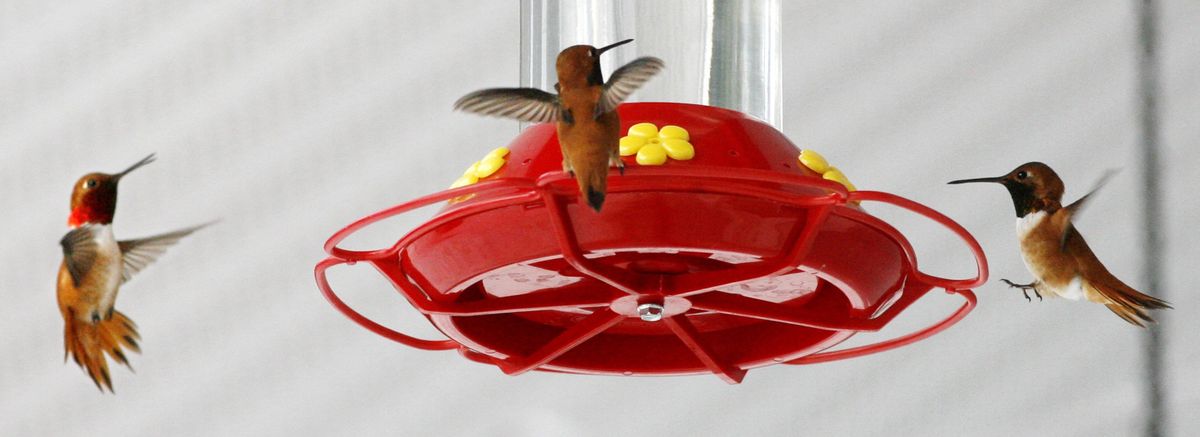Birds you’re hearing now in the Northwest may come from thousands of miles away

SEATTLE – Among the most prominent avian singers this time of year are our migrant visitors, some of whom have traveled thousands of miles, bringing vibrant color and song.
Migration allows birds to winter in warmer climates but demands superbird caloric feats.
In human terms, it’s the equivalent of a 150-pound person gaining 15 pounds of pure fat per day until tipping the scale at 300 pounds, then shedding 1.8 pounds per hour through vigorous exercise. A long-distance migrant such as a Swainson’s thrush will travel 125 miles a day from as far as the tropical forests of Mexico and Central and South America.
“So profound and hard-wired is the urge to travel in migratory species that even captive birds of their kind will be restless during the migratory season, fluttering their wings even as they stand in place, continuing the behavior for the same length of time it takes free fliers of their species to reach their destination,” wrote Lynda V. Mapes in a 2013 Seattle Times story. “Poignantly, the caged bird will also face its intended direction of travel.”
Whitney Neufeld-Kaiser, a Western Washington birder who teaches classes on how to identify birds by song, introduces some of the birds you’re most likely to hear in the Pacific Northwest this summer.
Black-headed grosbeak (Pheucticus melanocephalus)
If the American robin you’re listening to doesn’t quite sound right, it might actually be a black-headed grosbeak. Their song is similar to that of the robin, but sweeter, more lilting and faster in tempo.
Wilson’s warbler (Cardellina pusilla)
Warblers’ songs are among the most challenging to identify. Wilson’s warblers sing a short, descending staccato series of “chit” notes that often become more emphatic toward the end of the song.
Yellow warbler (Setophaga petechia)
Their songs are a bright, cheerful, rapid series of musical notes that tumble down in pitch. A phrase people commonly use to remember their song is: “Sweet, sweet, sweet-I’m-so-sweet.”
Common yellowthroat (Geothlypis trichas)
The common yellowthroat, a warbler of the wetlands, can be surprisingly difficult to see due to its bright gold throat and upper breast. Each individual male knows only one song, which often sounds like “wichity wichity wichity wichity.”
Warbling vireo (Vireo gilvus)
This bird’s song is a rich, burbling, varied warble (hence the name) that almost always ends on a high-pitched accented note. Common translations of its song are “Receiver, receiver, receipt!” and “If I sees you, I will seize you, and I’ll squeeze you till you squirt!”
Savannah sparrow (Passerculus sandwichensis)
This bird is a good reason to keep your pooch leashed in big city parks: They make their nests on the ground in thick grass. The Savannah sparrow’s song starts with a series of high-pitched, short, accelerating “tsip” notes, followed by a long insectlike buzz that carries a great distance, ending with a few rapid staccato tick notes.
Western tanager (Piranga ludoviciana)
Another American robin mimic, the western tanager’s song is typically shorter and raspier or “hoarser” than that of the robin, and punctuated with their characteristic call, which sounds like “burr-deep” or “bur-dle-eep” or “pit-r-ick” or “pri-di-dik,” depending on your ears.
Osprey (Pandion haliaetus)
The only North American raptor that plunge-dives talons first to catch fish as their primary food source, ospreys make a variety of sounds, but one you may hear frequently is a series of high-pitched, evenly spaced musical chirps – sometimes from high in the sky.
Rufous hummingbird (Selasphorus rufus)
If you hear a sustained “zzzzzing” sound and see a flash of cinnamon darting in and out of the salmonberry flowers, you’re hearing a male rufous hummingbird. You can hear the high-pitched metallic trill as air passes over special feathers in their wings.
Swainson’s thrush (Catharus ustulatus)
The Swainson’s thrush has one of the most beautiful songs in our lowland forests, an upwardly winding spiral of complex fluted notes. This shy brown-and-cream bird is related to the American robin.